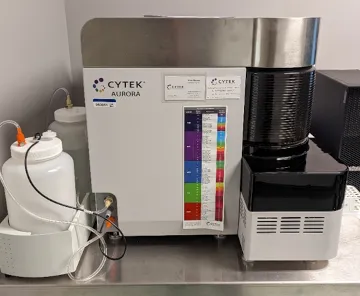Flow Cytometry and Cell Sorting Facility
Flow cytometry is the science of examining physical and chemical properties of live cells, beads or other biological particles as they pass in a fluid stream through a measuring apparatus. This apparatus, known as a flow cytometer, uses laser excitation and signal detection to measure parameters such as size, shape, DNA content, surface receptors, enzyme activity, membrane permeability and calcium flux.
On this page:
Some flow cytometers, called sorters, are equipped to separate and collect cells or beads of interest. High-performance flow cytometers and high-speed cell sorters have applications in cancer and HIV research, drug discovery, stem cell and gene therapy.
The Ottawa Hospital Research Institute Flow Cytometry Facility, located at the General Campus of the Ottawa Hospital, was established in 1998 and now includes three flow cytometers, two of which have sorting capabilities. We offer the sorting precision required for the isolation of rare cell populations with high purity and yield, up to 20,000 events per second. As well as sorting, flow cytometers allow the simultaneous analysis of a variety of light scatter and fluorescence parameters on single cells.
Please follow the Sample Preparation Guidelines when using the Flow Cytometry Facility services.
Important announcement
The facility is glad to announce that we have incorporated the Cytek Aurora spectral cytometer to our core facility. It is located at the Ottawa Hospital Cancer Centre, 3rd floor, room 3.325. The instrument has 5 lasers and 64 fluorescence detection channels, allowing you to run up to 40 colors in one run
For further information, training, and usage, please contact Fernando Ortiz, fortiz@ohri.ca.

Laboratory services
Flow cytometry
- Immunophenotyping/immunofluorescence by monoclonal antibodies.
- Total/Absolute population counts.
- Analysis of surface and intracellular fluorescent labelling, simultaneously.
- Monitoring gene transfer and expression using fluorescent proteins.
- Simultaneous detection and sorting of GFP and YFP.
- DNA content and cell cycle analysis using PI, Hoechst, BrDU, etc.
- Hoechst 33342 side population.
- Cell viability with exposure to drugs, toxins, etc.
- Apoptosis.
- Caspase activity.
- Telomere length measurement.
- Neutrophil functions (phagocytosis and oxidative burst).
- NK cytolytic activity.
- MLR / CTL cytotoxicity.
- Caspase activity.
- Mitochondrial function (DiO, JC-1)
- Intracellular Calcium Flux.
- Q-Prep whole blood lysis.
Cell sorting
- High-speed cell sorting.
- Cell sorting of one to four subpopulations.
- Large particle sorting.
- Single cell deposition in multi-well plates.
Antibody testing and compensation matrix
Additional service is offered for antibody testing of mouse, rat and hamster origin using antibody capture beads. These beads are a useful tool to detect the intensity of your antibodies and to calculate the compensation matrix in experiments with more than 6 parameters.
Training
- Flow cytometry basic training is intended for students, technicians and investigators wanting to strengthen their background and understanding of flow cytometry. The 2-hour session will provide the participants with the required tools for setting up successful flow cytometry experiments.
- Specific flow cytometry training is offered on an as-needed basis. Please contact the facility coordinator for further details.
Locations
Core Facility / MoFlo XDP Instrument
The Ottawa Hospital Sprott Centre for Stem Cell Research
Critical Care Wing, 5th Floor, Room W5145
501 Smyth Road
Ottawa, Ontario K1H 8L6
BD LSR Fortessa
The Ottawa Hospital Sprott Centre for Stem Cell Research
Critical Care Wing, 5th Floor, Room W5215
501 Smyth Road
Ottawa, Ontario K1H 8L6
SONY MA900 Instrument
The Ottawa Hospital Cancer Centre
3rd Floor, South Wing, Room 3340E
501 Smyth Road
Ottawa, Ontario K1H 8L6
Cytek Aurora Instrument
The Ottawa Hospital Cancer Centre
3rd Floor, South Wing, Room 3325E
501 Smyth Road
Ottawa, Ontario K1H 8L6
Contact us
To ask for information regarding flow cytometry and cell sorting technology, fluorescence panel set up, BD LSR Fortessa usage or book an appointment for MoFlo XDP, please contact Fernando Ortiz, the core facility laboratory manager.
Fernando Ortiz
Facility Manager, Flow Cytometry and
Cell Sorting Core Facility
613-737-8899 x73916
613-739-6294
Shahriar Sheikholeslami
Flow Cytometry and Cell Sorting Operator
613-737-8899 x73629
To ask for information regarding training, maintenance and usage of the SONY MA900, please contact, Carole Dore, Cancer Centre Lab Manager.